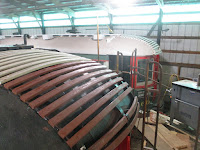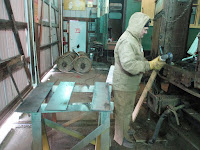Time for another progress report from Barn 4.
Good progress was made on the lobster traps. I removed a few more slats from the forms in the shop and took them out to the #1 end to start installation. Then all of the other forms were put back in the shop, and all remaining slats that had been soaking were bent to shape and clamped. In the picture below, two of them have extra bending so they will fit the bottom part of the assembly.
It was warm enough for primer, so I started on the #2 end as seen here. The bottom surfaces can be painted with a small trim roller; that seems to work well. I decided I didn't want to go up on top of the car to paint the other half today.
When it gets a little warmer, I'll need to apply some caulk in various places, and then it will be time for black paint.
Nick came along and suggested a better shot of the two North Shore cars alongside each other.
I did some more trimming and painting on the saddles at the #1 end, and then started attaching a few slats. They will then need to be removed, redrilled, countersunk, trimmed, and so on. But by now I almost know what I'm doing... I think.
The other regulars certainly seem to know what they're doing. This is the west end of the 1808, with parts of the structure badly rusted out.
Gerry is working hard on grinding and welding to fix it. Behind him you can see the new steel that will be welded in place.
And here he's grinding down the new pieces.
Tim continues working on doors and windows for the car.
John spent all day sanding down and finishing window moldings for the 306.
And I was very happy to see the progress that's being made on the compressor for the 36. Here we see the pistons and rods.
And looking inside the cylinders, with the crankshaft visible at rear.
Finally, since I'm done with soaking wood for now, I started siphoning the water out of the cylinder so it can be moved, emptied, and cleaned up. I ran out of time so that will get finished next time.
So today was a day for us to do what we have been doing, and what we did got done. What more could anyone want?













4 comments:
These roof mats are the single most significant visual improvement to the cars I can think of , I am very happy you took this on !!!
Randy Stahl
Thanks. This has been an interesting challenge, but it's a lot of work and I'm not sure I want to do another one anytime soon. It's certainly been educational and I'm happy to provide advice to anyone who needs it.
Somebody was asking me if these North Shore mats were originally installed by the carbuilders, and after looking through books I'm pretty sure the answer is yes (for the steel cars). It would be a lot easier to make saddles that fit properly and have screws in the right places while the roof itself was under construction.
But if I have a choice, the next thing I would like to do is a new roof on the 460. By now I know exactly what the issues are going to be. Almost like a production line.
I’m also certain the cars were built with roof mats. I will remind you however that in many wreck photos the roofs were in rough shape with mats either partially or completely stripped off. Highwood shops had to re-apply many roof mats. I don’t understand why many of these damaged or destroyed roof mats were not eliminated like the 757 after a wreck?
I know thatv757 was built with roof mats, I think they were removed in the late 40s but why?I have not seen any documented evidence that 757 was wrecked 763 a different story , there is documented evidence it was wrecked but the roof mats were re-applied
Yes, all the cars were built with roof mats at the carbuilder. They were generally neater and more uniform than the efforts of the carpentry shop at Highwood after a wreck or routine roof replacement. I'd go so far to say that most if not all of the roof mats on cars at the end of service in 1963 were 2nd or 3rd generation mats as replaced at Highwood. The "missing tooth" was not a feature of roof mats done at the carbuilder, it showed up on Highwood roof jobs as a matter of convenience for climbing onto the roof.
757's roof mats were removed on purpose in 1949 as an experiment per the late John Horachek. The idea was to emulate the "swoop" of red up the roof similar to an Electroliner around its headlight, so the mats were removed and a red crest added up the middle of the roof. The result was horrendous; 757 looked as if it had been scalped by an Indian. Subsequently, cars got the red swoops up the roof (like on 251 today), but kept the roof mats. Highwood never bothered to replace the mats on 757, and in fact it had grab irons attached to compensate for the lack of step provided by the mats. This was the only car to lose the mats completely in service on the railroad.
In preservation, 160, 749, 761, and now 714 have successfully had the roof mats restored to a roof or canvas replacement project. Other cars (like 251 and 709) still carry their original (pre-1963) roofs and thus their mats are similarly original. Hopefully the trend continues that mats get replaced on cars missing them; as Randy S. points out it's a big improvement to the cars' look. 757 restored as a Silverliner will of course remain scalped as it should.
-Zach
Post a Comment